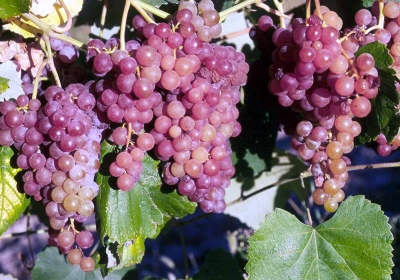
- Authors: University of Arkansas, USA
- Berry color: pink
- Taste: pleasant, labrus
- With bones: No
- Ripening period: very early
- Ripening period, days: 105-110
- Frost resistance, ° C: -27
- Name synonyms: RPS, Arkansas 1163, Rilines
- Bunch weight, g: according to Potapenko - 80-100, according to the originator - 300
- Yield: 120-150 c / ha
The Rylines Pink Seedlis variety has been cultivated by winegrowers from different countries for 40 years. Perfectly proved itself as a frost-resistant, ultra-early grape without seeds. Suitable for planting in mid-lane conditions. It is widely used in the production of wines, and is also good fresh and dried.
Breeding history
In 1964, breeders from the University of Arkansas are experimenting with the development of a frost-resistant grape variety. Crossing the Ontario and Suffolk Red varieties resulted in a Rylines Pink Siddles hybrid. For 8 years, the creators have observed experimental vineyards in the states. The new variety has successfully withstood winter temperatures below –34 degrees Celsius, and the taste of the new berries was highly appreciated during tasting.
Geography of distribution
It is believed that Rylines Pink Siddles is suitable for cultivation in the conditions of central Russia. But it must be borne in mind that the northernmost states of the United States are at a latitude that is almost 10 degrees south of Moscow, thus planting and fruiting in colder climates is associated with a certain risk.
Description
The grape is distinguished by vigorous shrubs with strong vines covered with dark green leaves. This variety is often planted by gardeners as a pollinator for other grapes.
Ripening period
The Rylines Pink Sidlis variety belongs to the very early: from the beginning of budding to the ripening of berries, it takes from 105 to 110 days. In the southern regions of Russia, the berries turn pink starting in August, in the central regions - from September.
Bunches
The berries are collected in dense cylindrical bunches weighing up to 300 g.
Berries
Small fruits of a round shape when ripe become white-pink or bright pink, size - from 1.4 to 2.7 g. The peel is firm, but not thick, when chewed soft, separated by bags. The bones are absent, if any, then not developed, soft.
Taste
The pulp is fleshy and juicy, melts in the mouth, the aroma contains strawberry-pineapple shades, the taste is characterized as pleasant, labrus. Contains up to 24% sugar, and the acidity is low - 6-7 g / l.
Yield
It is considered a high-yielding grape: fruit ripening is more than 80%. Begins to bear fruit in 4 years, the average yield is 8-10 kg per bush.


Growing features
The hybrid is considered one of the most frost-resistant varieties, it has good survival rate and growth rate. During the development of new vines and ripening of fruits, the soil must be regularly loosened, fertilized and watered.
Landing
For seedlings, open and light areas protected from the wind are chosen. The soil should not become waterlogged after floods, prolonged rains. The grapes are undemanding to the soil, but grows poorly on calcareous soils, prefers loose clay or stony, carbonate or slightly carbonate.
Accommodation - 3x1.5 meters. Drainage must be laid in the grooves for planting by 1/3, fertile soil is poured over it, which, if necessary, is deoxidized with organic matter. Planted in spring: late April - early May, or in autumn, 3-4 weeks before the onset of cold weather. In the middle lane, this is October - early November. The plant needs support immediately after planting.

Pollination
The variety is self-pollinated. The flowers are bisexual, they do not need additional pollination.
Pruning
The young vines are protected from growths, they are carefully cut off so as not to damage the rest of the plant. Before wintering, the grapes are recommended to be cut into 6-8 eyes, and then sheltered from cold and dampness.

Watering
It is advised to water with warm water. In a temperate climate, there is enough moisture for the bush, watered only if there is a drought. Mulching helps conserve water. In areas with a dry climate, watering is not stopped even after the harvest. On sandy soils, they often watered little by little, on clay soils - abundantly, but rarely. From excess moisture, the berries begin to crack. Recommended water charging irrigation in the spring.


Top dressing
The first top dressing is placed in the pit during planting. In the spring, it is recommended to fertilize the soil with nitrogenous compounds, during the period of setting and ripening of berries, specialized complex fertilizing is applied.
Frost resistance and the need for shelter
The variety does not need shelter, but gardeners recommend covering young plants. An adult bush in the southern regions, where the thermometer does not drop below -27 degrees, does not need shelter. In severe winters, they are insulated with straw and covered with a film, creating an air bubble around the plant. The most common dry hiding place. To insulate the roots, a layer of mulch is laid.

Diseases and pests
Resistant to most diseases. There is a susceptibility to mildew, oidium. Preventive measures are carried out in early spring before bud break: they are treated with Bordeaux liquid and insecticides. These remedies are recommended to be used after pruning diseased shoots for treatment. Insects and birds are scared away with special noise devices.

If a grape is exposed to any disease or insect, this always affects its appearance.
Storage
Bunches for transportation are collected at the stage of technical ripeness. When stored cold, the berries are up to 3 months.











































































